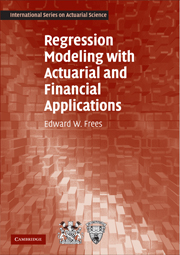Book contents
- Frontmatter
- Contents
- Preface
- 1 Regression and the Normal Distribution
- Part I Linear Regression
- Part II Topics in Time Series
- Part III Topics in Nonlinear Regression
- Part IV Actuarial Applications
- 16 Frequency-Severity Models
- 17 Fat-Tailed Regression Models
- 18 Credibility and Bonus-Malus
- 19 Claims Triangles
- 20 Report Writing: Communicating Data Analysis Results
- 21 Designing Effective Graphs
- Brief Answers to Selected Exercises
- Appendix 1 Basic Statistical Inference
- Appendix 2 Matrix Algebra
- Appendix 3 Probability Tables
- Index
21 - Designing Effective Graphs
Published online by Cambridge University Press: 05 June 2012
- Frontmatter
- Contents
- Preface
- 1 Regression and the Normal Distribution
- Part I Linear Regression
- Part II Topics in Time Series
- Part III Topics in Nonlinear Regression
- Part IV Actuarial Applications
- 16 Frequency-Severity Models
- 17 Fat-Tailed Regression Models
- 18 Credibility and Bonus-Malus
- 19 Claims Triangles
- 20 Report Writing: Communicating Data Analysis Results
- 21 Designing Effective Graphs
- Brief Answers to Selected Exercises
- Appendix 1 Basic Statistical Inference
- Appendix 2 Matrix Algebra
- Appendix 3 Probability Tables
- Index
Summary
Chapter Preview. Actuaries, like other business professionals, communicate quantitative ideas graphically. Because the process of reading, or decoding, graphs is more complex than reading text, graphs are vulnerable to abuse. To underscore this vulnerability, we give several examples of commonly encountered graphs that mislead and hide information. To help creators design more effective graphs and to help viewers recognize misleading graphs, this chapter summarizes guidelines for designing graphs that show important numerical information. When designing graphs, creators should
(1) Avoid chartjunk.
(2) Use small multiples to promote comparisons and assess change.
(3) Use complex graphs to portray complex patterns.
(4) Relate graph size to information content.
(5) Use graphical forms that promote comparisons.
(6) Integrate graphs and text.
(7) Demonstrate an important message.
(8) Know the audience.
Some of the guidelines for designing effective graphs, such as (6), (7), and (8), are drawn directly from principles for effective writing. Others, such as guidelines (3), (4), and (5), come from cognitive psychology, the science of perception. Guidelines (1) and (2) have roots both in effective writing and in graphical perception. For example, the writing principle of brevity demonstrates how eliminating pseudo three-dimensional perspectives and other forms of chartjunk improve graphs. As another example, the writing principle of parallel structure suggests using small multiple variations of a basic graphical form to visualize complex relationships across different groups and over time.
To underscore the scientific aspect of graphical perception, we examine the process of communicating with a graph, beginning with a sender's interpretation of data and ending with a receiver's interpretation of the graph.
- Type
- Chapter
- Information
- Regression Modeling with Actuarial and Financial Applications , pp. 505 - 528Publisher: Cambridge University PressPrint publication year: 2009

